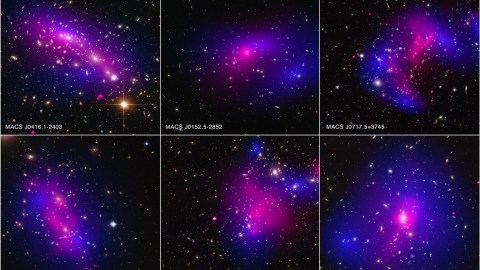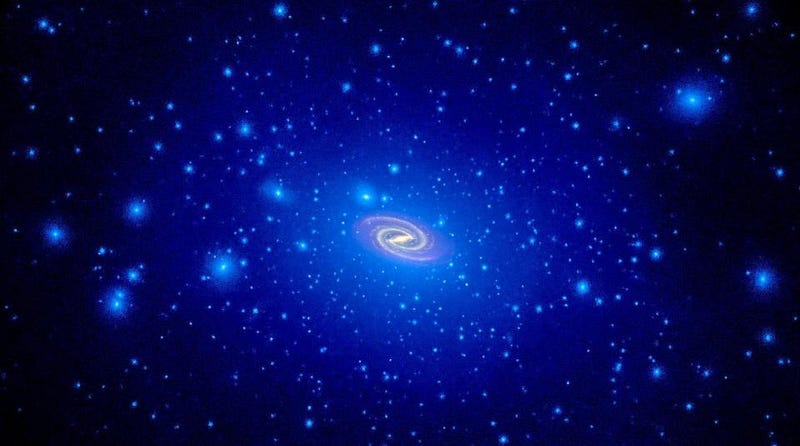Dark matter faces its biggest challenge of all

A correlation between normal matter and the observed rotation suggests that maybe dark matter isn’t a certainty, after all.
“Nothing in the standard cosmological model predicts this, and it is almost impossible to imagine how that model could be modified to explain it, without discarding the dark matter hypothesis completely.” –David Merritt
When it comes to the largest things we can observe in the Universe — galaxies, clusters of galaxies and even larger assemblies of structures — all of the normal matter present, in all its forms, cannot explain the motions that we see. In order to make what we see jibe with what must exist, we need an extra component to the Universe: some form of invisible, massive material, known as dark matter. Yet a new study shows that if we look at individual galaxies in great detail, the dark matter explanation might not hold up well at all.

In the 1930s, scientists noticed that individual galaxies within a large, massive galaxy cluster (the Coma Cluster, shown above) were moving far too fast for how much normal matter was present. If all that existed were protons, neutrons and electrons, the galaxies would fly apart rather than being bound together into a cluster at these speeds! In the 1970s, a similar problem was noticed for individual galaxies: they rotated more quickly, especially at the outskirts, than the matter present would predict based on the laws of gravity. Both of these problems could be resolved if a new type of matter — dark matter — were found throughout the Universe. The additional gravitational force provided by a massive species of matter that didn’t interact with light, normal matter, electromagnetism or the nuclear forces would result in a large, spherical “halo” of dark matter surrounding the most massive bound structures.

Based on this idea, if this new form of matter were present, it would have been present from the very earliest stages of the Universe’s history, going back to the Big Bang. The specific predictions that result from the assumption of dark matter’s existence are overwhelming:
- That the Universe would form a very specific web-like type of large-scale structure,
- That structures on large, small and medium scales would appear in a specific pattern,
- That galaxy clusters would appear with certain size, mass and magnitude distributions,
- That there would be a particular pattern of fluctuations that appear on a variety of scales in the cosmic microwave background, and
- That colliding galaxy clusters would exhibit a separation of normal matter and X-rays from the gravitational, dark matter mass.
All of these predictions have since been spectacularly confirmed by observations, with the last of them often cited as an empirical proof for the existence of dark matter.
https://players.brightcove.net/2097119709001/4kXWOFbfYx_default/index.html?videoId=5131037086001
But despite the success of dark matter in explaining how our observations of the largest scales ought to turn out, the relatively small scales — the scales of individual galaxies — show some problems. For one, if you assume that dark matter is a particle of a particular mass that doesn’t interact through any force except gravitation, you find that every galaxy, cluster and satellite should have the same universal density profile. In all cases, this means the core should have the most dark matter, and then as you move away, the density should drop according to a particular law, and then at a critical juncture the density should drop according to a different, steeper law. Different simulation parameters give different profiles, but this feature is something they all have in common.

Yet in a new paper accepted for publication in Physical Review Letters, scientists Stacy McGaugh, Federico Lelli and James Schombert observed 153 different galaxies with a wide variety of shapes, masses, sizes, and amounts of gas. Scientist Brian Koberlein wrote about this a week ago, detailing a number of potential explanations for why this occurs. What we see, however, is not up for debate. In some of the galaxies, the normal matter is a substantial fraction of what’s there; in others, dark matter totally dominates.

Yet in all of them, a very interesting and unexpected property shows itself: there’s a relationship between the observed gravitational acceleration and the distribution of the normal (baryonic, or protons, neutrons and electrons) matter alone. In other words, if you measure how quickly the galaxies rotate, it seems to depend — within a reasonable set of errors — only on the presence of the normal matter. Given that some of these galaxies are Milky Way-like or larger, while others are less than 1% the mass and allegedly dominated by dark matter, this result is not at all what you might expect!

If dark matter is truly responsible for this gravitational behavior, it needs to be able to explain why this relationship should emerge. The dark matter “halos” predicted by the naive simulations do not lead to realistic galaxies. Now, there could be new physics that dark matter obeys that we haven’t yet uncovered that might explain this, including:
- self-interactions among the dark matter particles,
- weak interactions between dark matter and normal matter particles,
- fluid-like behavior, gravitational polarization or “condensation” properties (bosonic or fermionic) of dark matter.

As professor Arthur Kosowsky (who was not involved in the research)states,
“The standard model of cosmology is remarkably successful at explaining just about everything we observe in the universe. But if there is a single observation which keeps me awake at night worrying that we might have something essentially wrong, this is it.”
If dark matter is right, it has to explain why the normal matter appears to be correlated with a galaxy’s rotational properties so well. And if it can’t explain it, we just might have to rethink all of dark matter’s apparent successes, and reframe them in terms that might make us extremely uncomfortable from a cosmological point of view. If dark matter isn’t right, then Einstein’s theory of gravitation might not be the full story, either. Either way, the 21st century promises to reveal some amazing science in our quest to uncover the truth of what the Universe is really made out of.
This post first appeared at Forbes, and is brought to you ad-free by our Patreon supporters. Comment on our forum, & buy our first book: Beyond The Galaxy!




